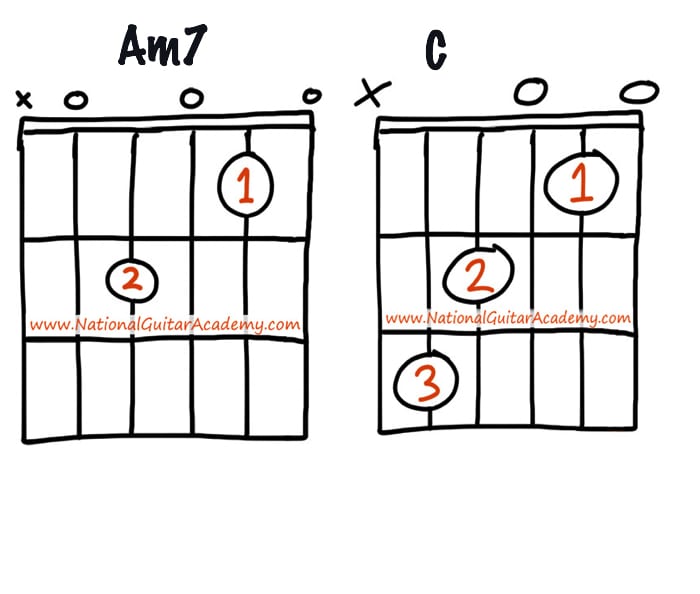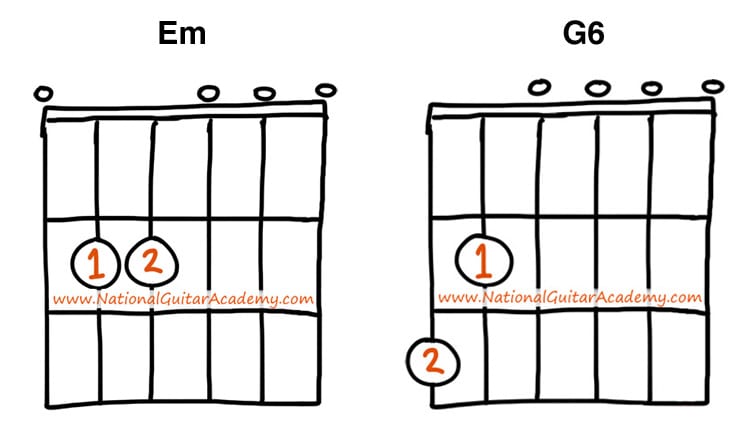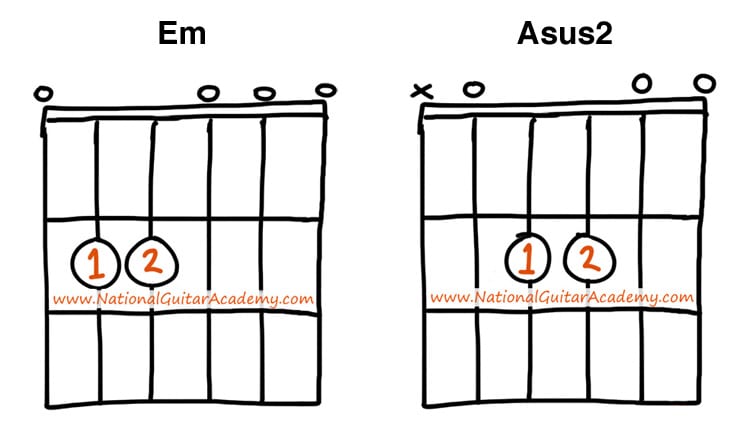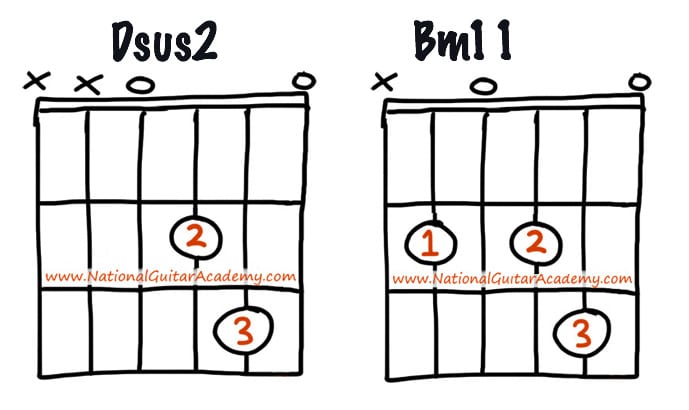Guitar lessons for beginners need to be easy, simple and practical. We want you to make music as quickly as possible so let’s get started.
As a guitar beginner it’s important to get off to the right start and we’re going to do just that with 3 quick guitar lessons for beginners.
- We’ll start with some easy chord transitions.
- Then we’ll look at simple strumming patterns.
- Lastly, we’ll look at a brilliant beginner lead guitar scale.
The aim is to get you making music that sounds good as quickly as possible. Guitar should always be a pleasure and never a chore.
Over 100,000 guitar-learners get our world-class guitar tips & tutorials sent straight to their inbox:
Click here to join them
Get our best guitar tips & videos
Chords should always come first
Chords are the first thing you should focus on. There are exceptions, but 99% of the time focussing on chords sets new guitarists on the best path to success.
No matter what genre of music you’re looking to play, you need to know your chords.
Even if lead guitar is your ultimate ambition, chords are the essential foundation to understanding the guitar.
Start off with EASY chords
There are many different types of chords. Some are easy to play and some are an absolute swine to play. Pick the chords you learn first carefully! 🙂
I often see beginners trying to learn guitar using hard chords like C and D. This is crazy. The best guitar lessons for beginners are based around simple chords.
The first chords you learn should be simple (aim for 2-finger chords at first) and in an EASY chord progression (ie, it’s easy to get from one chord to the next).
Guitar Lessons For Beginners – Lesson 1
Ok, let’s get started. There are 6 chord exercises in lesson 1. When you’re searching the internet for guitar lessons for beginners you need to make sure those lessons meet your first goal:
Your first goal as a guitar learner is simply to get comfortable holding the instrument and moving between EASY chords (ideally, in a fluid way).
Here’s a few super-easy chord exercises that are ideal for beginners…
Don’t think of these following chords as ‘baby’ chords. I’ve been playing guitar for 24 years and I still play these chords all the time because they still sound great!
If you’re unsure how to read the chord diagrams below, check out our guide: How To Read Chordboxes In 60 Seconds
Exercise 1: Em to G6
This is a great beginner exercise. Strum down on each chord 4 times. When you get comfy with that, add the upstrokes in.
Listen to the audio to hear how this should sound:
.
Transitioning back and forth between these two chords is one of my favourite guitar lessons for beginners because:
- It’s easy: It takes just one finger to transition to the next chord.
- It sounds good: These two chords are closely related and sound good together.
- It’s important: These are two of the most common guitar chords of all.
- It helps with strumming: Because the chord change is easy, you can quickly start to focus on your strumming. That’s where the rhythm is. That’s where the MUSIC is! 🙂
This has quite a rocky sound, especially if you just strum the two or three thickest strings. Have a play and see what you think.
‘Horse With No Name’ by America can be played in its entirety with just these two chords.
Guitar lessons for beginners (Exercise 2) – Em to Asus2
This is another one of my favourite guitar lessons for beginners. Two cool chords and the change is pretty easy.
Listen to this audio clip to hear the timing and what this should sound like.
.
TOP TIP: If you want to improve your strumming you have to work on it with a song that has EASY chords. (Otherwise, you will constantly be distracted by the chord changes, rather than focussing on the musicality of your right hand.)
Learn 12 EASY beginner chords with our popular guide


Where should we send it?
✅ Stop struggling. Start making music.
✅ Learn beginner-friendly versions of every chord.
This is our most popular guide and it will improve your chord ability quickly! 😎
Get your own personalised guitar-learning plan 🎸
Get a custom guitar-learning plan here: Click here for GuitarMetrics™
World-Class Guitar Courses 🌎
Learn from the world's best guitar educators: Click here for our guitar courses
Guitar lessons for beginners (Exercise 3) Am7 to C
This is one of the best guitar lessons for beginners because Am and C are very closely related and crop up together all the time.

These chords have a very mid-heavy sound and are well balanced for pretty much all styles of music.
Play these chords in the same pattern as the others: downstrokes to begin with, then add the upstrokes in.
Note that both of these chords are played on the first five strings of the guitar. Try not to hit that low E string (the 6th string) as it will muddy these chords.
Top tip: for all these chords, strum with a pick, not with your thumb. They will sound louder and clearer that way.
Guitar lessons for beginners (Exercise 4) Dsus2 to Bm11
This is another one of my favourite guitar lessons for beginners because it starts to develop the dexterity of your fingers in a more intricate way.
These chord names sound complicated, but they’re not too complicated to play.
Try bouncing back and forth in the strumming pattern we used for the earlier chords.
As with the previous example, skip the low E string on both chords and also leave out the A string out on the Dsus2.
Guitar lessons for beginners (Exercise 5) Fmaj7 to Dsus9
Ok this is a cool, indie-tastic chord transition. Check it out:
Try and create your own strumming pattern for this one. How do these chords make you feel? Should you play this fast or slow? What feels ‘right’ to you?
Both these chords are played on just the first four strings of the guitar. Leave the low E string and the A string out.
Want free guitar tips and video lessons delivered to your inbox?
Join over 100,000 guitar learners and subscribe to our guitar-tips-by-email service. (It's free.)
We'll send you a series of lessons that will move you to the next level of your guitar journey.
Learn how everything fits together quickly, easily and effectively. We share ninja tips (for instant fun!) but also timeless fundamentals that will deepen your understanding.


Get our best guitar tips & videos
Our Guitar Courses
To become a better guitarist click here to see our guitar courses
Get your personalised guitar-learning plan 🎸
Want us to make a guitar-learning plan that is customised to you? Click here for GuitarMetrics™
Guitar lessons for beginners (Exercise 6) E to B7
Ok, let’s try something a bit harder. We’re going to try a different strumming tempo here.
Listen to the audio to learn how to approach this a bit differently. We’re going to strum quickly here:
.
The E chord uses all six of the strings, but with the B7 we want to leave the low E string out.
For a bit of fun, why not time yourself on these chord changes? How many times can you change from Em7 to G6 and back in 30 seconds? What about the other chord changes here? Are you quicker at some than others? Try testing yourself like this once a week and see how much quicker you’ve gotten at each change.
“My fingers hurt”
Yeah, they will at first, BUT… as you practice more and more your fingertips become calloused and won’t hurt any more when you press on the strings.
It helps a lot if you use extra light strings on your guitar. (Get your guitar re-stringed at your local guitar shop, it will cost around $15 / £15.)
Cool beginner songs
Of course, we don’t just want to play these chords for the sake of it. We want to use them in songs.
Check out this article, it rocks! 10 Easy Songs For Guitar Beginners











